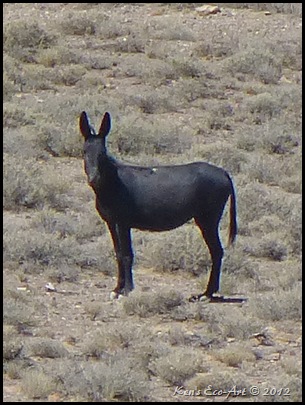08/02/2012 Trip Notes: On a roadtrip to Lake Tahoe to visit family, I was driving just 15 miles south of Tonapah, Nevada, when I spotted these half-dozen wild burros (Donkey) grazing only about 70 feet away from the west side of the US-95 highway. By the time I stopped, grabbed my camera and began to approach them, they spooked and ran more than 200 hundred yards away before they stopped and returned a gaze back in my direction. These handheld shots were taken with my 200mm telephoto lens. Over the past 10 years I have passed this area more than a dozen times and have never spotted even one of these animals, let along a herd of six. As a result, I feel that the prospect of sighting a band of wild burros in their natural, historic habitat to be quite rare, and therefore felt quite privileged. Because they tend to be very observant, they don’t let people get very close to them.
|
 Description: Wild Burro (Donkey) (Equus asinus). A donkey is the descendant of the African wild ass (of which there are only about 500 left in the wild today). Donkeys are a different species than a horse, but in the same family. They were originally bred in Egypt or Mesopotamia around 5,000 years ago. There is not a formal cutoff between the terminology "donkey," "burro", "mule" and "ass". A small donkey is sometimes called a burro (from the Spanish word for the animal). Burros grow to be about half the size of a horse and weigh between 400 and 600 pounds. Burros also "bray" instead of "whinny". Males are called jacks, and females are called jennies. The differences between horses and burros are generally easy to see. Burros have longer ears and short manes and tails. Though those in these pictures appear to meet this criteria, I have yet to find any pictures on the Internet of an all black burro. Babies are born once per year usually between March and July. In the wild, mountain lions are the only natural predator. Nevada is home to most of the nation's wild burros. In fiscal year 1988 the estimate was 1,318 burros, which has grown significantly since then. Wild burros can quickly overpopulate an area. They have long life spans and are not very susceptible to predation or disease. Left unchecked, wild burro numbers can double in four years. That can severely impact desert rangelands with scattered, small water sources like we have in Nevada. To bring wild horse and burro numbers in balance with the available food and water, BLM gathers hundreds of excess wild horses and burros from Nevada ranges every year. Once captured, excess animals are transported to BLM corral facilities where they are vaccinated to prevent illness or disease and given lots to eat and drink. BLM also assigns each animal a unique number – or freeze mark. Once they are ready, they are made available for adoption through BLM’s Adopt-A-Burro Program. Description: Wild Burro (Donkey) (Equus asinus). A donkey is the descendant of the African wild ass (of which there are only about 500 left in the wild today). Donkeys are a different species than a horse, but in the same family. They were originally bred in Egypt or Mesopotamia around 5,000 years ago. There is not a formal cutoff between the terminology "donkey," "burro", "mule" and "ass". A small donkey is sometimes called a burro (from the Spanish word for the animal). Burros grow to be about half the size of a horse and weigh between 400 and 600 pounds. Burros also "bray" instead of "whinny". Males are called jacks, and females are called jennies. The differences between horses and burros are generally easy to see. Burros have longer ears and short manes and tails. Though those in these pictures appear to meet this criteria, I have yet to find any pictures on the Internet of an all black burro. Babies are born once per year usually between March and July. In the wild, mountain lions are the only natural predator. Nevada is home to most of the nation's wild burros. In fiscal year 1988 the estimate was 1,318 burros, which has grown significantly since then. Wild burros can quickly overpopulate an area. They have long life spans and are not very susceptible to predation or disease. Left unchecked, wild burro numbers can double in four years. That can severely impact desert rangelands with scattered, small water sources like we have in Nevada. To bring wild horse and burro numbers in balance with the available food and water, BLM gathers hundreds of excess wild horses and burros from Nevada ranges every year. Once captured, excess animals are transported to BLM corral facilities where they are vaccinated to prevent illness or disease and given lots to eat and drink. BLM also assigns each animal a unique number – or freeze mark. Once they are ready, they are made available for adoption through BLM’s Adopt-A-Burro Program.
Wild burros evolved in the deserts of northern Africa and parts of Asia. They adapted to hot, dry summers, cold winters and marginal food sources. These traits combined with physical strength made the burro a useful pack animal. Burros were first brought to the "New World" by early Spanish explorers and were used by prospectors and sheep herders. The burro prefers Indian ricegrass and four-wing saltbush, but will eat whatever it can to survive. During the hot summer months, the burros are usually within two miles of water, especially females with young foals. As fall approaches, the burros disperse and are found at the higher elevations and up to six miles from water. Wild burros have been known to walk 15 miles without water and then drink five gallons in two and a half minutes, a capability surpassed only by the camel.
|